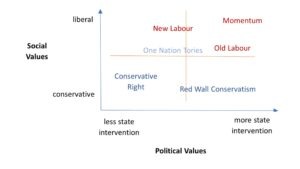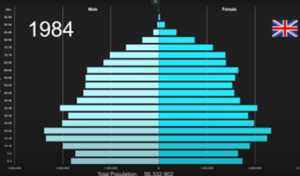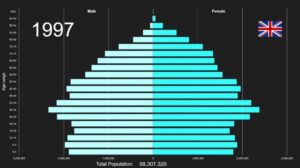Voter Perception
The political spectrum is not just right versus left; it exists on two axis:

The first rule of winning a General Election in the UK is to win the vote in at least two of the four boxes. To win a landslide, you must appeal to three boxes or pull more voters into the boxes you represent.
In the 2019 election, the Labour Party ignored this first rule while the Conservatives succeeded.
After the false confidence of the better-than-expected results in 2017, Jeremy Corbyn’s Labour firmly planted its flag in a single box. It failed to attract voters from the broader spectrum. On the other hand, under Boris Johnson, the Conservatives were just enough of a political chameleon to pick up votes across the spectrum.
In 2024, the picture has reversed.
With Brexit having driven out the One Nation Tories, the Liz Truss experiment, the promotion of the culture wars, anti-state conservatives increasingly dominating the media, and in trying to defend themselves against the Reform Party, the Conservatives have trapped themselves in a box of their own making. This is why we will see many off-the-cuff policy announcements from the Conservatives in the next few weeks as they try to break back out of that box.
At the same time, the criticism of Kier Starmer being vague about his principles is by design – in the same way that Boris Johnson managed to be unclear about his political values. Kier Starmer must be vague enough to appeal across the spectrum, even if it drives away some of the more traditional left wings. Although he’d hate the comparison, Kier Starmer is following Boris’s lead. Boris was at heart socially liberal and small state, but also loved the political expediency of a big shiny spending project and was happy to dip in and out of social conservatism.
This is all about voter perception, which shifts over time, and it is likely that this voter perception is now set in stone and little that happens in the next few weeks will change the picture.
Demographics
The second most important factor in determining who governs is how many people sit in each box.
Where you sit on the political spectrum is heavily influenced by where you sit in the demographic statistics.
Age is a crucial determining factor in how you align politically.

During the 80s, the baby boomer population was in its 20s. This large voting block swung heavily to the top left corner of the spectrum: increasingly socially liberal but also increasingly small state and lower taxes. In your 20s, as you start working, you tend to resent the tax you pay each month, and you want to keep as much money as you can and spend it – buying a car and a house is a greater priority than public services. In your 20s, you consume fewer public services and value them less – you’re not at school, you don’t have children, you don’t want public housing, you move from public transport to a car, you want a job and to buy a house. The visible breakdown of the state in the 70s – strikes and the failures of nationalisation – also drove this generation away from the big state. Thatcher’s political domination of the 80s was based on this voting block aligning in the top left to the then political values of the Conservative Party – a small state but with a significant faction of One Nation Tory social liberalists.
New Labour Landslide

By the late 90s, the baby boomer generation was in its 30s and now had families and children. You can see both the baby boomer bulge above and the bulge from when they had children. When you have children, your political values change. Suddenly, the tax you pay each month represents excellent value for money. You want good schools, public transport, parks, libraries, police, and free nursery places. When you have children, you tend to be a net recipient of state spending. New Labour rode this demographically driven change in political sentiment.
Breaking the Red Wall
By 2019, the baby boomer generation was in their 50s. Again, the political priorities changed. Your kids have moved out, and you have stopped being a net consumer of public services again. A big motivator becomes wealth generation and preservation. You’re at your peak earning power and looking towards how you finance your retirement. You want lower taxes and policies that specifically preserve your wealth. Those who don’t have wealth to protect want more state resources allocated to the elderly. You haven’t had grandchildren yet, so you lose contact with the youth population and become more socially conservative. Liberal social values have become much less important, and more of the population has moved back into the bottom half of the spectrum. This drove the red wall wave-ridden by the Conservatives in 2019.
2024 – Reuniting the Generations or Increasing Polarisation?
In 2024, for the first time in 40 years, the baby boomer generation no longer holds the balance of political power. The millennials now almost match them. Once again, public services are important to both groups: millennials with children and retired baby boomers. Socially liberal attitudes are regaining their political power. To win the election in 2024, parties need to not just appeal across the political spectrum but also across the demographic spectrum. For the past 40 years, winning the vote of the baby boomers was enough to guarantee victory; that is no longer possible. The Conservative strategy of politicising the baby boomers and motivating them to vote is not enough to keep them in government, as it has been for the past 14 years.
Population Density
In addition to age, there is a significant correlation between population density and where people sit on the political spectrum. While causation can be argued, the greater the density, the more likely you are to be socially liberal and support state spending. This impact of lived experience on your political views is similar to how your age impacts your views and priorities.
Living in densely urban areas, the state and public services are far more visible, and their value is more apparent. Similarly, the population will likely be younger and more diverse, impacting your social views. In rural areas, the opposite is true; voters lean more socially conservative – wanting to protect what they see as their way of life – and public services can often be largely invisible, meaning rural areas lean towards the bottom left of the spectrum. It’s understandable. Across an acre of rural Wales, the government may only spend a few thousand pounds yearly. The government will likely be spending millions yearly in an acre of central London.
This means that General Elections are won and lost in the suburban areas – where demographics’ impact on the political spectrum varies and sways the most over time.
Why the next few weeks still matter – voter turnout
While demographic trends and their impact on the political spectrum dictate who wins elections, the scale of that victory is impacted by voter turnout.
A list of the permissible forms of voter ID gives some hint at the Conservative strategy here:
Older Person’s Bus Pass funded by the UK Government
60+ London Oyster Photocards funded by Transport for London
Freedom Pass
Scottish National Entitlement Card issued for the purpose of concessionary travel (including a 60+, disabled or under 22s bus pass)
60 and Over Welsh Concessionary Travel Card
Senior SmartPass issued in Northern Ireland
60+ SmartPass issued in Northern Ireland
The Conservatives need a high turnout of older voters while hoping that younger voters are too apathetic to vote. Labour needs a high turnout, and that is their most significant risk to a large majority – that they have put off traditional hardcore voters and stay at home. Who doesn’t vote has as much impact as who does vote – see the Brexit referendum.
Plaid Cymru, the Liberal Democrats and the SNP
I will be criticised if I portray this as only a two-horse race.
Plaid faces a dilemma in finding clear ground on the political spectrum. In Scotland, the SNP successfully supplanted Labour in the top half of the spectrum. That was easier in Scotland than it would be in Wales. In Scotland, 83% of the population lives in urban areas, and the SNP could concentrate its resources on replacing Labour in densely populated areas and build significant momentum. In Wales, just 65% of the population lives in urban areas, and the Plaid heartlands tend to be more rural. This has made it difficult for Plaid to challenge Labour, while at the same time, it’s hard for them to attract voters away from the Conservatives, who want less government in Wales, not more. Voter demographics are Plaid’s biggest challenge. If Plaid Cymru can find a way to unite the often opposing priorities of rural and urban voters as the party of Wales, then it could erode some of the Labour support, especially if it can tap into voter apathy towards both the Conservatives and the Labour Government in Wales – the Vote of No Confidence this week could help them.
The Liberal Democrats struggle even more to find that empty political ground to occupy. They tend to do best when there is clear water between Labour and the Conservatives, and they can attract the more centrist voters, which isn’t the case this time around. The Liberal Democrats, by nature, lean towards social liberalism, but their target voters in more affluent rural constituencies tend to lean towards social conservatism; that’s where they always struggle. The Greens are also challenged by not appealing enough across the broader political and social spectrum.
Conclusion
A Labour Government in Westminster looks baked in. Only if the noise around policies and personalities over the next few weeks impacts voter turnout will all the campaigning affect the size of their majority.
*This article has been written by our Chief Executive and does not necessarily represent the views of the firm.











